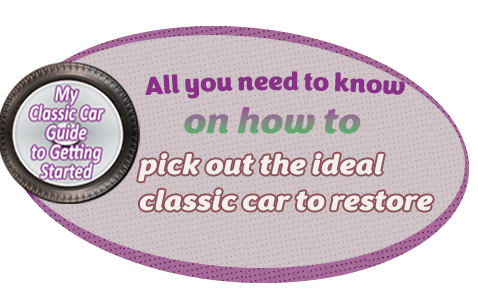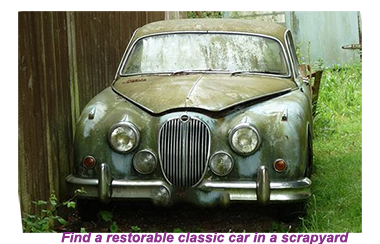 Choosing the ideal classic car to restore is one of the most daunting challenges that a restorer will have to go through.
Choosing the ideal classic car to restore is one of the most daunting challenges that a restorer will have to go through.
 In practice, this situation only exists once in a million. Finding a restorable classic that fits all the essential criteria can usually involve a long search until the right vehicle comes along.
Apart from the auction alternative, which is usually too rich for most people’s blood, three other paths are to be taken to find the ideal classic car.
Buying from a scrapyard- The history of classic car restoration is dotted with stories of lucky people who, when scouring a scrap yard, probably searching for parts, or driving along a secluded country road, came across a “diamond in the rough” in the corner of the year which they bought for a song and restored to its former cost at a fraction of its value.
In practice, this situation only exists once in a million. Finding a restorable classic that fits all the essential criteria can usually involve a long search until the right vehicle comes along.
Apart from the auction alternative, which is usually too rich for most people’s blood, three other paths are to be taken to find the ideal classic car.
Buying from a scrapyard- The history of classic car restoration is dotted with stories of lucky people who, when scouring a scrap yard, probably searching for parts, or driving along a secluded country road, came across a “diamond in the rough” in the corner of the year which they bought for a song and restored to its former cost at a fraction of its value.
 Buying from a dealer- This method may seem very appealing from the outset, but what has to be borne in mind is that dealers rarely deal in restorable classics but mostly in classics that have already undergone a full restoration or at least a partial one with a price tag to match.
On the upside, a professional car dealer always will invest considerable effort in presenting the cars they have for sale in the best possible environment, creating an atmosphere that can sometimes lead a beginner restorer to lose track of their long-term goal and leave the showroom with a gleaming restoration that they played no part in, except writing the cheque.
Buying privately- Buying a restorable classic privately will almost always be a much more user-friendly experience. However, it will inevitably involve much travel, tons of patience and even a few disappointments until the right car comes along.
When a potential buyer gets a car in their sights, they should be focused entirely on their task and waste no time contacting the seller to get the lie of the land.
The first and most vital step is to ascertain if the seller is indeed “private” and not a dealer in disguise.
A few trial questions and probes should be enough to allow the potential buyer to certify that the car is indeed genuine, and an inspection visit can be arranged.
Buying from a dealer- This method may seem very appealing from the outset, but what has to be borne in mind is that dealers rarely deal in restorable classics but mostly in classics that have already undergone a full restoration or at least a partial one with a price tag to match.
On the upside, a professional car dealer always will invest considerable effort in presenting the cars they have for sale in the best possible environment, creating an atmosphere that can sometimes lead a beginner restorer to lose track of their long-term goal and leave the showroom with a gleaming restoration that they played no part in, except writing the cheque.
Buying privately- Buying a restorable classic privately will almost always be a much more user-friendly experience. However, it will inevitably involve much travel, tons of patience and even a few disappointments until the right car comes along.
When a potential buyer gets a car in their sights, they should be focused entirely on their task and waste no time contacting the seller to get the lie of the land.
The first and most vital step is to ascertain if the seller is indeed “private” and not a dealer in disguise.
A few trial questions and probes should be enough to allow the potential buyer to certify that the car is indeed genuine, and an inspection visit can be arranged.
 Even if travelling a long way to view a vehicle, the potential buyer should never allow this investment in time to affect their judgement. They should be prepared to walk away from the deal if it does not meet all their criteria.
Even if travelling a long way to view a vehicle, the potential buyer should never allow this investment in time to affect their judgement. They should be prepared to walk away from the deal if it does not meet all their criteria.
 Statistics show that when all the other alternatives have been investigated and usually discarded, the facts are that most first-time restorers prefer to buy privately rather than at an auction or through a dealer. The majority of private sellers are sympathetic people who are happy to see their much-loved former family car that grew to become a heirloom over the years and brought them pleasure and good memories fall into caring hands who will restore to its former glory.
Statistics show that when all the other alternatives have been investigated and usually discarded, the facts are that most first-time restorers prefer to buy privately rather than at an auction or through a dealer. The majority of private sellers are sympathetic people who are happy to see their much-loved former family car that grew to become a heirloom over the years and brought them pleasure and good memories fall into caring hands who will restore to its former glory.
Back to the homepage- and don't spare the horsepower.
Got a question, a comment, a suggestion or an offer??? - FEEL FREE TO CONTACT US ANYTIME!!;
A guide to acquiring, restoring and maintaining UK or European Classic Cars of the Fifties and Sixties- as well as a recollection of the iconic cars of the era and the visionaries that produced them.


